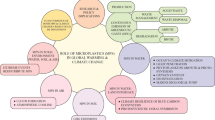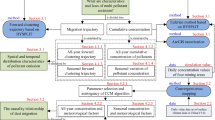Abstract
Year-long field observations have shown that there are spatial and temporal variations in the quantity of dust emissions for particulate matter \({<}\)10 \(\upmu \hbox {m}\) (PM10), particulate matter \({<}\)63 \(\upmu \hbox {m}\) (PM63) and vertical dust flux over different gravel surfaces (with loose sand, without loose sand, with a crust, and without a crust), with the greatest emissions occurring in the spring. The largest quantity of PM10 and PM63 emissions occurred over gravel with a loose sand surface (\(1.1 \times 10^{-3}\) and \(10.2 \times 10^{-3 }\hbox { kg m}^{-1}\hbox { day}^{-1}\), respectively). The gravel surface without loose sand and without a crust presents the lowest values of PM63 (\(1.6 \times 10^{-3 }\hbox { kg m}^{-1}\hbox { day}^{-1}\)) and PM10 (\(3.3 \times 10^{-4}\hbox { kg m}^{-1}\hbox { day}^{-1}\)). However, the vertical dust flux was largest at over sandy surface (\(373 \times 10^{-3 }\hbox { kg m}^{-2}\hbox { day}^{-1}\)). Multivariate correlation analysis indicates that the quantity of PM10 is strongly negatively correlated to gravel coverage (\(R^{2 }= 0.55\)). The quantity of PM10 dust emissions over a gravel surface with loose sand is approximately three times greater than that of a gravel surface with a crust. The mean quantity of PM10, PM63 and vertical dust flux over a gravel surface decreased with increasing gravel coverage. By comparing the quantity of PM10 dust emissions over gravel and sandy deserts, we found that gravel deserts and sandy deserts are both major sources of dust for dust storms in this region.






Similar content being viewed by others
References
Abdourhamane Touré A, Rajot ZG, Marticorena B, Petit C, Sebag D (2011) Impact of very low crop residues cover on wind erosion in the Sahel. Catena 85:205–214
Bagnold RA (1941) The physics of blown sand and desert dunes. William Morrow and Company, New York
Belnap J, Gillette DA (1998) Vulnerability of desert biological soil crusts to wind erosion: the influences of crust development, soil texture, and disturbance. J Arid Environ 39:133–142
Bhattachan A, D’Odorico P, Okin GS, Dintwe K (2013) Potential dust emissions from the southern Kalahari’s dunelands. J Geophys Res Earth Surf 118:307–314
Dong ZB, Liu XP, Wang XM (2002a) Aerodynamic roughness of gravel surfaces. Geomorphology 43:17–31
Dong ZB, Qu JJ, Liu XP, Zhang WM, Wang XM (2002b) Experimental investigation of drag coefficients of gobi surfaces. Sci China Ser D 45:609–615
Dong ZB, Lu JF, Man DQ, Lv P, Qian GQ, Zhang ZC, Luo WY (2011a) Equations for the near-surface mass-flux density profile of wind-blown sediments. Earth Surf Proc Land 36:1292–1299
Dong ZB, Su ZZ, Qian GQ, Luo WY, Zhang ZC, Wu JF (2011b) Aeolian geomorphology of the Kumtagh Desert. Science Press, Beijing
Folk RL, Ward WC (1957) Brazos River bar: a study in the significance of grain size parameters. J Sediment Petrol 27:3–26
Fryrear DW (1986) A field dust sampler. J Soil Water Conserv 41:117–120
Gillette DA, Blifford IH, Fenster CR (1972) Measurements of aerosol size distributions and vertical fluxes of aerosols on land subject to wind erosion. J Appl Meteorol 11:977–987
Gillette DA (1974) On the production of soil wind erosion having the potential for long range transport. J Rech Atmos 8:734–744
Gillette DA, Blifford IH (1974) Influence of wind speed on size distributions of aerosols generated by wind erosion of soils. J Geophys Res 79:4068–4075
Gillette DA, Adams J, Muhs D, Kihl R (1982) Threshold friction velocities and rupture moduli for crusted desert soils for the input of soil particles into the air. J Geophys Res 87:9003–9015
Gomes L, Rajot JL, Alfaro SC, Gaudichet A (2003) Validation of a dust production model from measurements performed in semi-arid agricultural areas in Spain and Niger. Catena 52:257–271
Kok JF, Parteli EJR, Michaels TI, Bou KD (2012) The physics of wind-blown sand and dust. Rep Prog Phys 75:106901
Laurent B, Marticorena B, Bergametti G, Chazette P, Mei FM, Schmechtig C (2005) Simulation of the mineral dust emission frequencies from desert area of China and Mongolia using an aerodynamic roughness length map derived from the POLDER/ADEOS surface products. J Geophys Res 110:D18S04
Laurent B, Marticorena B, Bergametti GP, Mei F (2006) Modeling mineral dust emissions from Chinese and Mongolian deserts. Glob Planet Change 52:121–141
Leenders JK, Sterk G, Van Boxel JH (2011) Modelling wind-blown sediment transport around single vegetation elements. Earth Surf Proc Landf 36(9):1218–1229
Leys J, McTainsh G (1994) Soil loss and nutrient decline by wind erosion—cause for concern. Aust J Soil Water Conserv 7(3):30–35
Lyles L (1988) Soil wind erodibility index in seven northern central states. Trans ASAE 31(5):1396–1399
Macpherson T, Nickling WG, Gillies JA, Etyemezian V (2008) Dust emissions from undisturbed and disturbed supply-limited desert surfaces. J Geophys Res 113:F02S04
Prospero JM, Ginoux P, Torres O, Nicholson SE, Gill TE (2002) Environmental characterization of global sources of atmospheric soil dust identified with the nimbus total ozone mapping spectrometer (TOMS) absorbing aerosol product. Rev Geophys 40(1):1002
Pye K (1987) Aeolian dust and dust storms. Academic Press, Gainesville, pp 121–129
Qian GQ, Dong ZB, Luo WY, Feng YM, Wu B, Yang WB (2014) Gravel morphometric analysis based on digital images of different gobi surfaces in northwestern China. J Desert Res 34(3):625–633 (in Chinese)
Rostagno CM, Degorgue G (2011) Desert pavements as indicators of soil erosion on aridic soils in north-east Patagonia (Argentina). Geomorphology 134:224–231
Shao Y, Raupach MR (1993) Effect of saltation bombardment on the entrainment of dust by wind. J Geophys Res Atmos 98(D7):12719–12726
Shen YB, Shen ZB, Du MY, Wang WF (2005) Dust emission over different land surface in the arid region of northwest China. J Meteorol Soc Jpn 83(6):935–942
Sweeney MR, McDonald EV, Etyemezian V (2011) Quantifying dust emissions from desert landforms, eastern Mojave Desert, USA. Geomorphology 135:21–34
Sweeney MR, Mason JA (2013) Mechanisms of dust emission from Pleistocene loess deposits, Nebraska, USA. J Geophys Res Earth Surf 118:1460–1471
Valentin C, Bresson LM (1992) Morphology, genesis and classification of surface crusts in loamy and sandy soils. Geoderma 55:225–245
Wang XM, Lang LL, Hua T, Wang HT, Zhang CX, Wang ZT (2012) Characteristics of the Gobi desert and their significance for dust emission in the Ala Shan Plateau (Central Asia): an experimental study. J Arid Environ 81:35–46
Xuan J, Sokolik IN (2002) Characterization of sources and emission rates of mineral dust in Northern China. Atmos Environ 36:4863–4876
Yang XH, He Q, Ali M, Huo W, Liu XC (2013) Sand flux estimation during a sand-dust storm at Tazhong area of Taklimakan Desert, China. J Arid Land 5(2):199–206
Zhang XY, Gong SL (2005) Contribution of the anthropogenic desertification in China to Asian dust storm. Adv Clim Change Res 1(4):147–150 (in Chinese)
Zhang ZC, Dong ZB (2014) The characteristics of aeolian transport particle size distribution over the artificial pebble surfaces. J Desert Res 34:639–644 (in Chinese)
Zhang XY, Zhang GY, Zhu GH, Zhang DE, Zhi S, Chen T, Huang XP (1996) Elemental tracers for Chinese source dust. Sci China Ser D 39(5):512–521 (in Chinese)
Zhang XY, Arimoto R, An ZS (1997) Dust emission from Chinese desert sources linked to variations in atmospheric circulation. J Geophys Res 102(D23):28041–28047
Zhang ZC, Dong ZB, Zhao AG (2008a) The effect of restored microbiotic crusts on erosion of soil from a desert area in China. J Arid Environ 7:710–721
Zhang BL, Tsunekawa A, Tsubo M (2008b) Contributions of sandy lands and stony deserts to long-distance dust emission in China and Mongolia during 2000–2006. Glob Planet Change 60:487–504
Zhang ZC, Dong ZB, Zhao AG (2011) The characteristics of aeolian sediment flux profiles in the southeastern Tengger Desert. Sedimentology 58:1884–1894
Zhang ZC, Dong ZB, Qian GQ, Li J, Jiang CW (2016a) Implications of surface properties for dust emission from gravel deserts (gobis) in the Hexi Corridor. Geoderma 268:69–77
Zhang ZC, Dong ZB, Zhang CX, Qian GQ, Lei CY (2016b) The geochemical characteristics of dust material and dust sources identification in northwestern China. J Geochem Explor. doi:10.1016/j.gexplo.2016.11.006
Zobeck TM, Fryrear DW (1986) Chemical and physical characteristics of windblown sediment. Quantities and physical characteristics. TASAE 29:1032–1036
Acknowledgements
We gratefully acknowledge the Long term location and observation of Gobi ecosystem (201404304), Youth Innovation Promotion Association of the Chinese Academy of Sciences (2015348), Technology of the People’s Republic of China (2013CB956000), the West Light Foundation of the Chinese Academy of Sciences CAS, and the Natural Science Foundation of Gansu Province. In addition, we thank MogoEdit for the language editing.
Author information
Authors and Affiliations
Corresponding author
Electronic supplementary material
Below is the link to the electronic supplementary material.
Rights and permissions
About this article
Cite this article
Zhang, Z., Dong, Z., Qian, G. et al. An Investigation into the Processes and Quantity of Dust Emissions over Gravel and Sand Deserts in North-Western China. Boundary-Layer Meteorol 163, 523–535 (2017). https://doi.org/10.1007/s10546-017-0235-4
Received:
Accepted:
Published:
Issue Date:
DOI: https://doi.org/10.1007/s10546-017-0235-4




